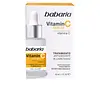What's inside
What's inside
 Key Ingredients
Key Ingredients

 Benefits
Benefits

 Concerns
Concerns

 Ingredients Side-by-side
Ingredients Side-by-side

Water
Skin ConditioningPropylene Glycol
Humectant3-O-Ethyl Ascorbic Acid
Skin ConditioningAlcohol Denat.
AntimicrobialTocopheryl Acetate
AntioxidantTri (Polyglyceryl-3/Lauryl) Hydrogenated Trilinoleate
EmulsifyingPolyisobutene
Polysorbate 20
EmulsifyingSorbitan Isostearate
EmulsifyingPolyacrylate-13
Parfum
MaskingTetrasodium EDTA
Xanthan Gum
EmulsifyingBenzoic Acid
MaskingDisodium EDTA
Sorbic Acid
PreservativeSodium Polyacrylate
AbsorbentCitric Acid
BufferingBenzyl Alcohol
PerfumingLimonene
PerfumingHexyl Cinnamal
PerfumingLinalool
PerfumingGeraniol
PerfumingWater, Propylene Glycol, 3-O-Ethyl Ascorbic Acid, Alcohol Denat., Tocopheryl Acetate, Tri (Polyglyceryl-3/Lauryl) Hydrogenated Trilinoleate, Polyisobutene, Polysorbate 20, Sorbitan Isostearate, Polyacrylate-13, Parfum, Tetrasodium EDTA, Xanthan Gum, Benzoic Acid, Disodium EDTA, Sorbic Acid, Sodium Polyacrylate, Citric Acid, Benzyl Alcohol, Limonene, Hexyl Cinnamal, Linalool, Geraniol
Water
Skin ConditioningCoco-Caprylate/Caprate
EmollientNiacinamide
SmoothingCalcium Pantothenate
Sodium Ascorbyl Phosphate
AntioxidantTocopheryl Acetate
AntioxidantPyridoxine Hcl
Skin ConditioningMaltodextrin
AbsorbentSodium Starch Octenylsuccinate
AbsorbentSilica
AbrasiveGlycerin
HumectantCarbomer
Emulsion StabilisingHydrolyzed Rice Protein
Skin ConditioningCamellia Japonica Seed Oil
EmollientSodium Hyaluronate
HumectantPolyglyceryl-2 Caprate
EmulsifyingDisodium EDTA
Hydroxyacetophenone
AntioxidantParfum
MaskingLinalool
PerfumingGeraniol
PerfumingSodium Hydroxide
BufferingWater, Coco-Caprylate/Caprate, Niacinamide, Calcium Pantothenate, Sodium Ascorbyl Phosphate, Tocopheryl Acetate, Pyridoxine Hcl, Maltodextrin, Sodium Starch Octenylsuccinate, Silica, Glycerin, Carbomer, Hydrolyzed Rice Protein, Camellia Japonica Seed Oil, Sodium Hyaluronate, Polyglyceryl-2 Caprate, Disodium EDTA, Hydroxyacetophenone, Parfum, Linalool, Geraniol, Sodium Hydroxide
 Reviews
Reviews

Ingredients Explained
These ingredients are found in both products.
Ingredients higher up in an ingredient list are typically present in a larger amount.
Disodium EDTA plays a role in making products more stable by aiding other preservatives.
It is a chelating agent, meaning it neutralizes metal ions that may be found in a product.
Disodium EDTA is a salt of edetic acid and is found to be safe in cosmetic ingredients.
Learn more about Disodium EDTAGeraniol is used to add fragrance/parfum to a product. It is the main component of citronellol. It is a monoterpenoid and an alcohol.
Monoterpenes are naturally found in many parts of different plants.
Geraniol can be found in many essential oils including Rose Oil and Citronella Oil. The scent of Geraniol is often described as "rose-like". Many foods also contain Geraniol for fruit flavoring.
Geraniol can irritate the skin when exposed to air. However, irritation depends on the ability of geraniol to penetrate into the skin. In general, geraniol is not able to penetrate skin easily.
Geraniol is colorless and has low water-solubility. However, it is soluble in common organic solvents.
Like citronellol, it is a natural insect repellent.
2,6-Octadien-1-ol, 3,7-dimethyl-, (2E)-
Learn more about GeraniolLinalool is a fragrance and helps add scent to products. It's derived from common plants such as cinnamon, mint, citrus, and lavender.
Like Limonene, this ingredient oxidizes when exposed to air. Oxidized linalool can cause allergies and skin sensitivity.
This ingredient has a scent that is floral, spicy tropical, and citrus-like.
Learn more about LinaloolParfum is a catch-all term for an ingredient or more that is used to give a scent to products.
Also called "fragrance", this ingredient can be a blend of hundreds of chemicals or plant oils. This means every product with "fragrance" or "parfum" in the ingredients list is a different mixture.
For instance, Habanolide is a proprietary trade name for a specific aroma chemical. When used as a fragrance ingredient in cosmetics, most aroma chemicals fall under the broad labeling category of “FRAGRANCE” or “PARFUM” according to EU and US regulations.
The term 'parfum' or 'fragrance' is not regulated in many countries. In many cases, it is up to the brand to define this term.
For instance, many brands choose to label themselves as "fragrance-free" because they are not using synthetic fragrances. However, their products may still contain ingredients such as essential oils that are considered a fragrance by INCI standards.
One example is Calendula flower extract. Calendula is an essential oil that still imparts a scent or 'fragrance'.
Depending on the blend, the ingredients in the mixture can cause allergies and sensitivities on the skin. Some ingredients that are known EU allergens include linalool and citronellol.
Parfum can also be used to mask or cover an unpleasant scent.
The bottom line is: not all fragrances/parfum/ingredients are created equally. If you are worried about fragrances, we recommend taking a closer look at an ingredient. And of course, we always recommend speaking with a professional.
Learn more about ParfumTocopheryl Acetate is AKA Vitamin E. It is an antioxidant and protects your skin from free radicals. Free radicals damage the skin by breaking down collagen.
One study found using Tocopheryl Acetate with Vitamin C decreased the number of sunburned cells.
Tocopheryl Acetate is commonly found in both skincare and dietary supplements.
Learn more about Tocopheryl AcetateWater. It's the most common cosmetic ingredient of all. You'll usually see it at the top of ingredient lists, meaning that it makes up the largest part of the product.
So why is it so popular? Water most often acts as a solvent - this means that it helps dissolve other ingredients into the formulation.
You'll also recognize water as that liquid we all need to stay alive. If you see this, drink a glass of water. Stay hydrated!
Learn more about Water